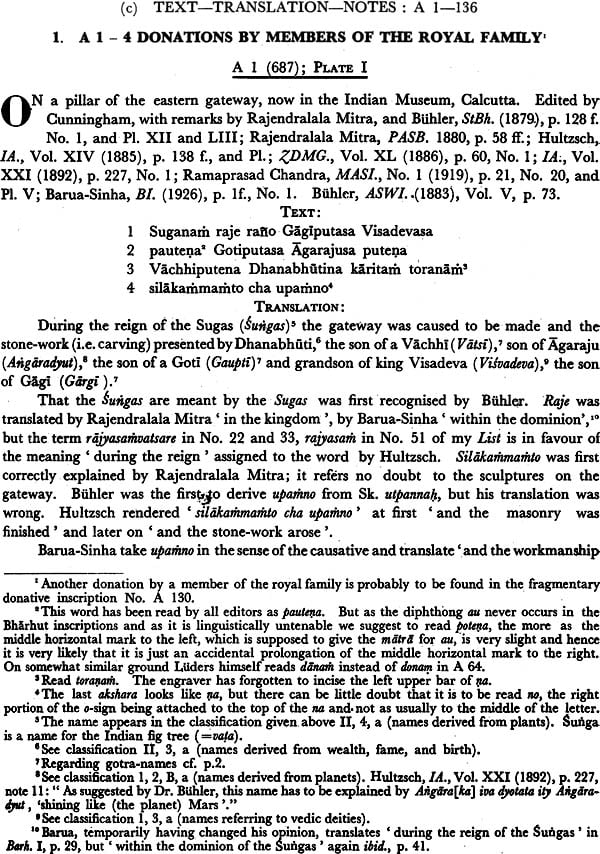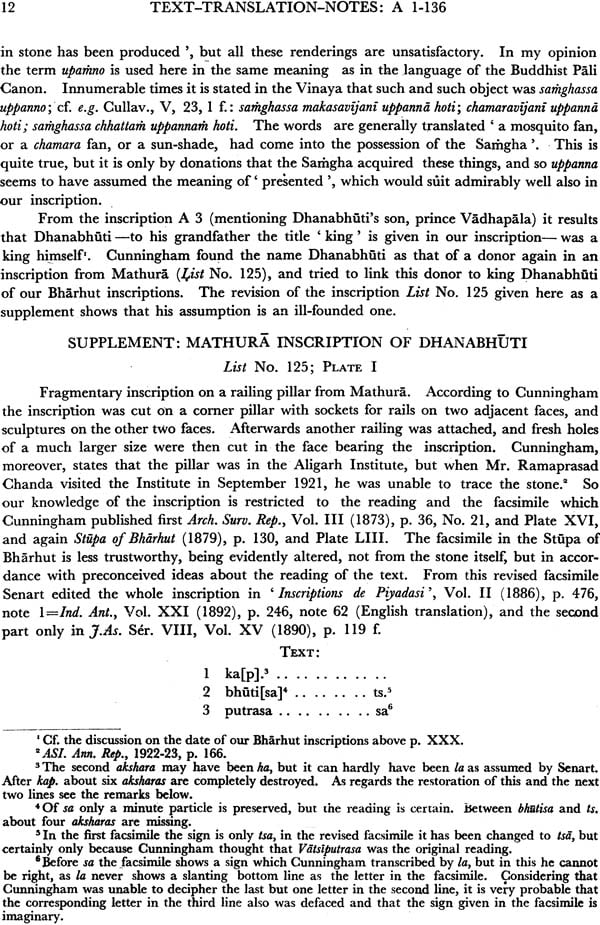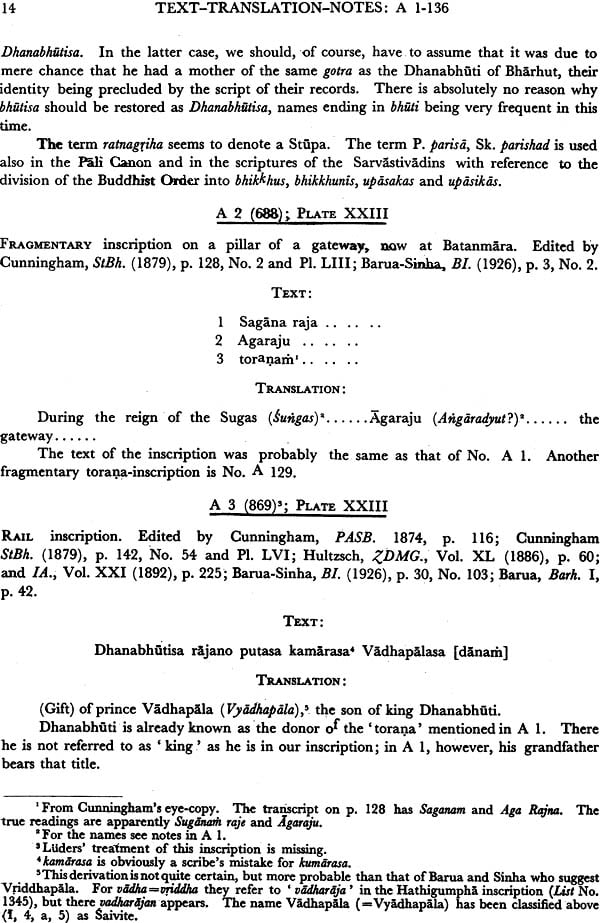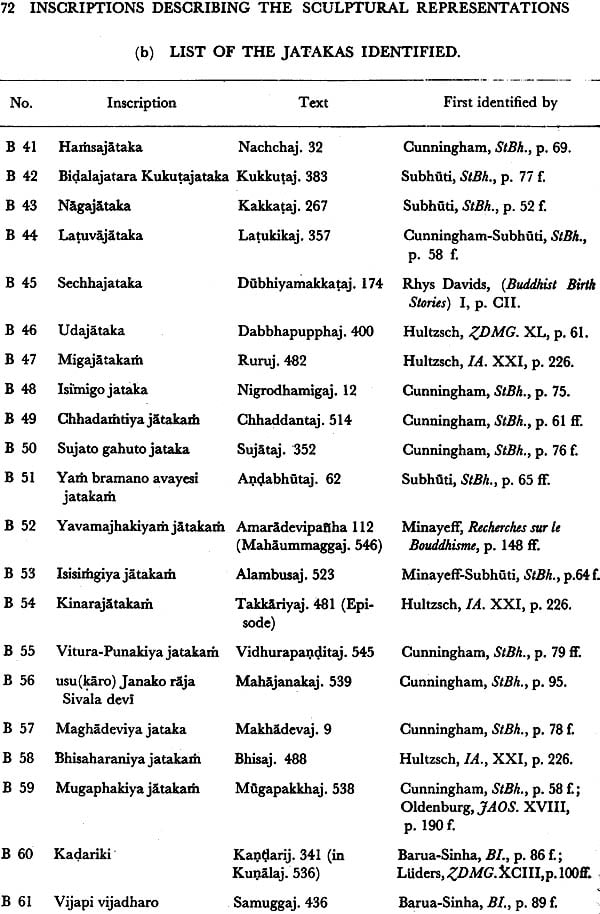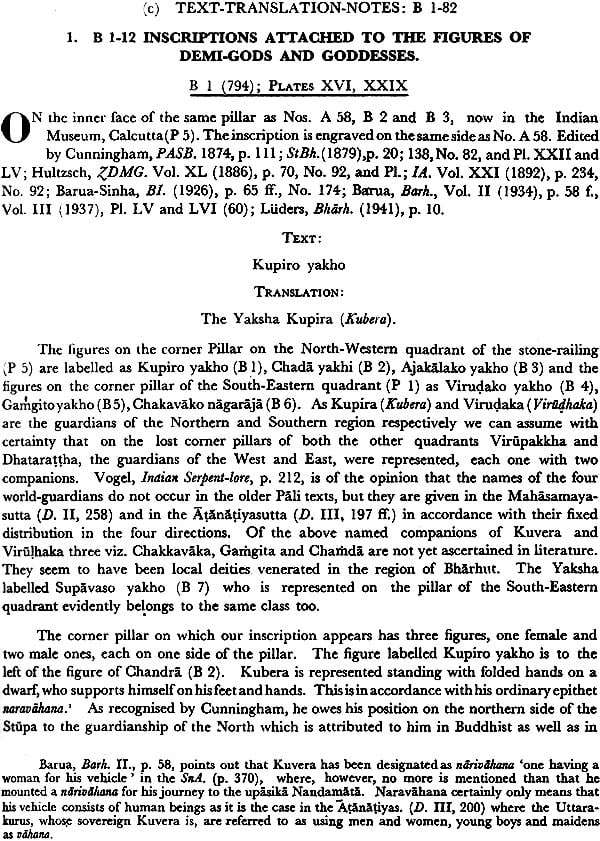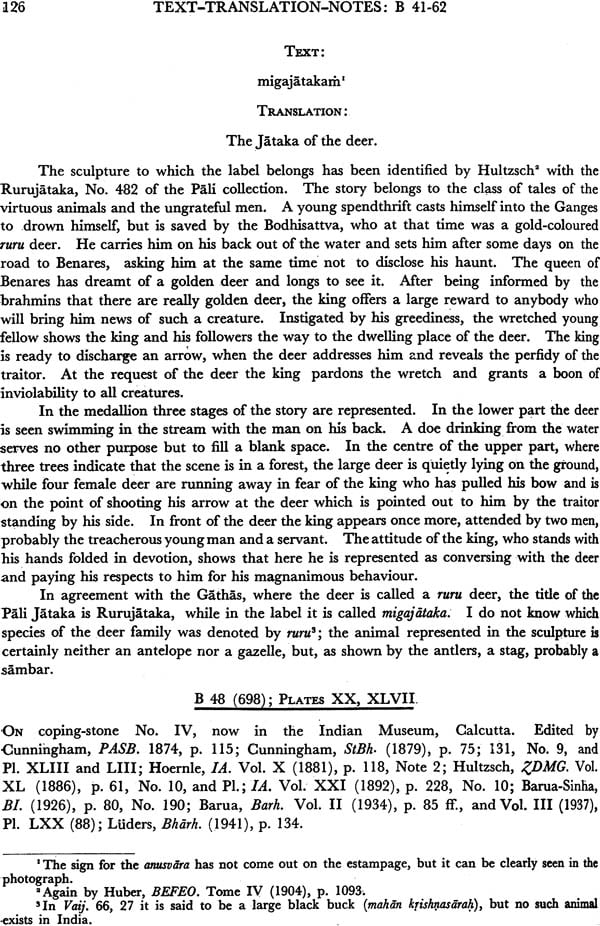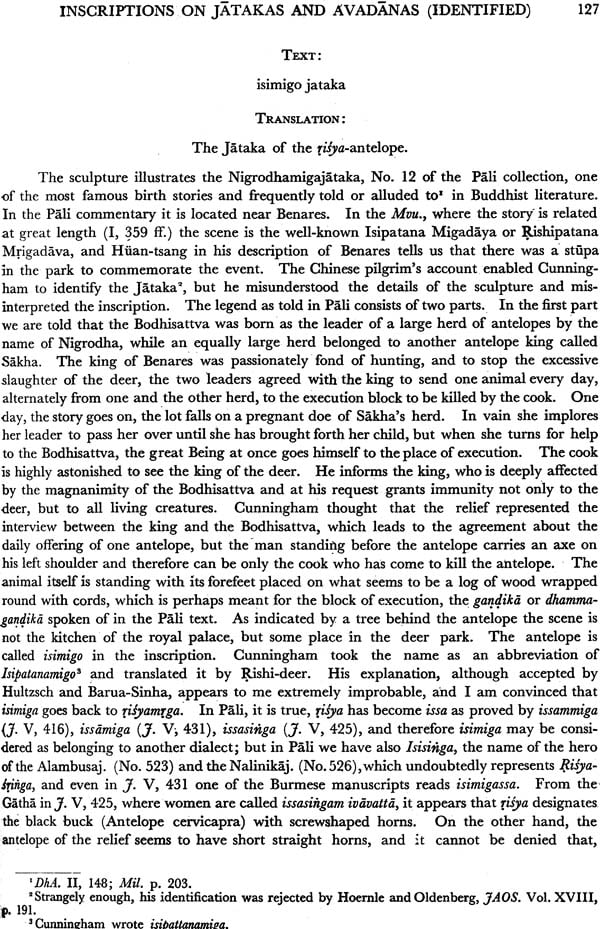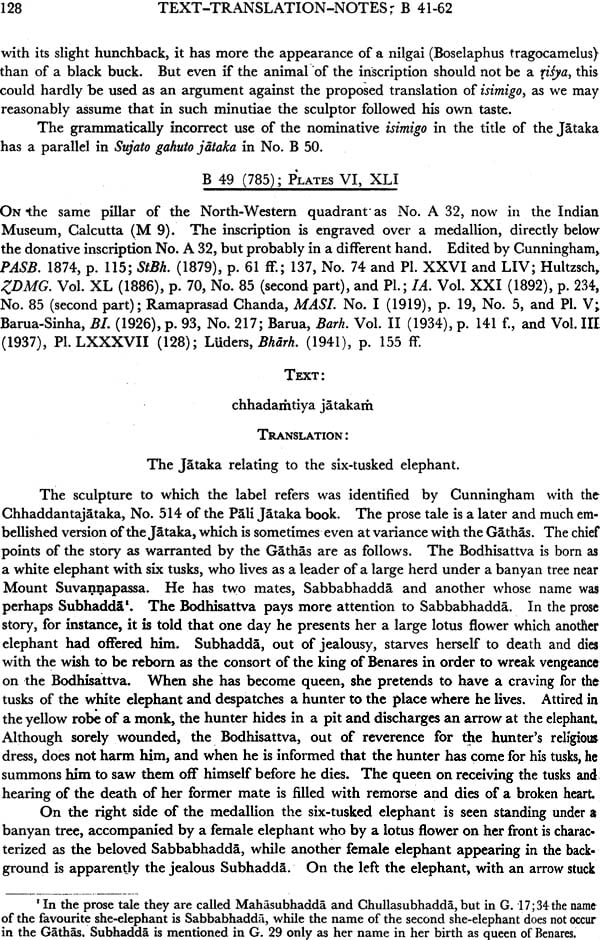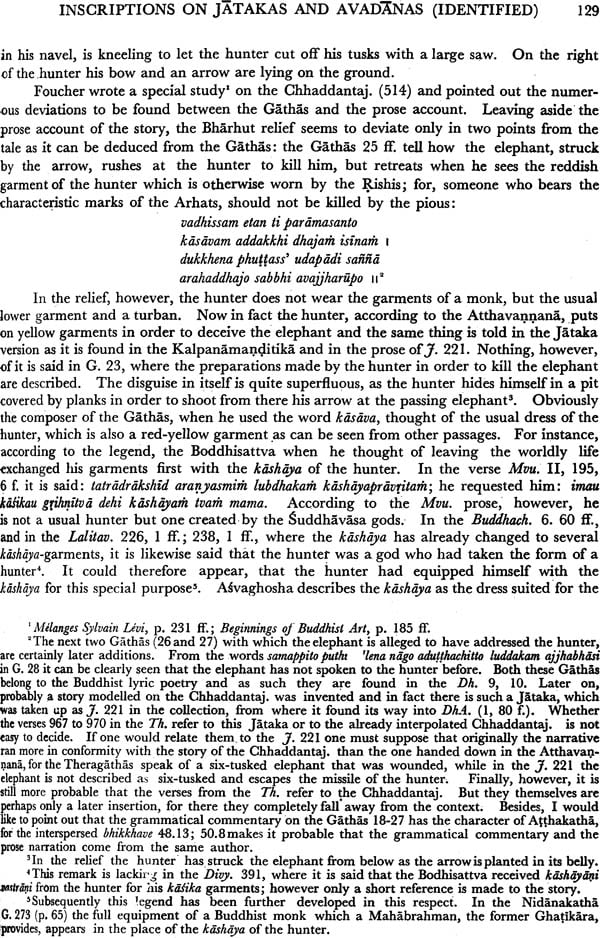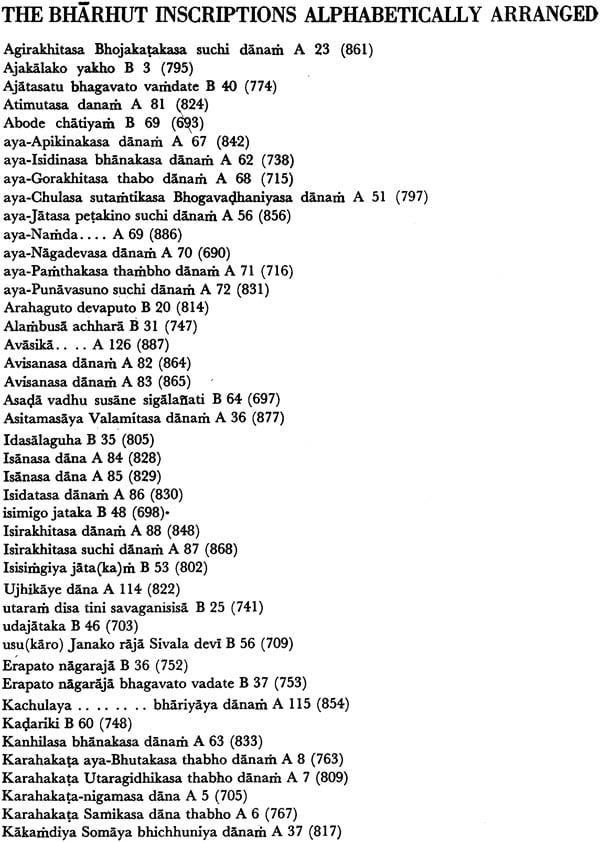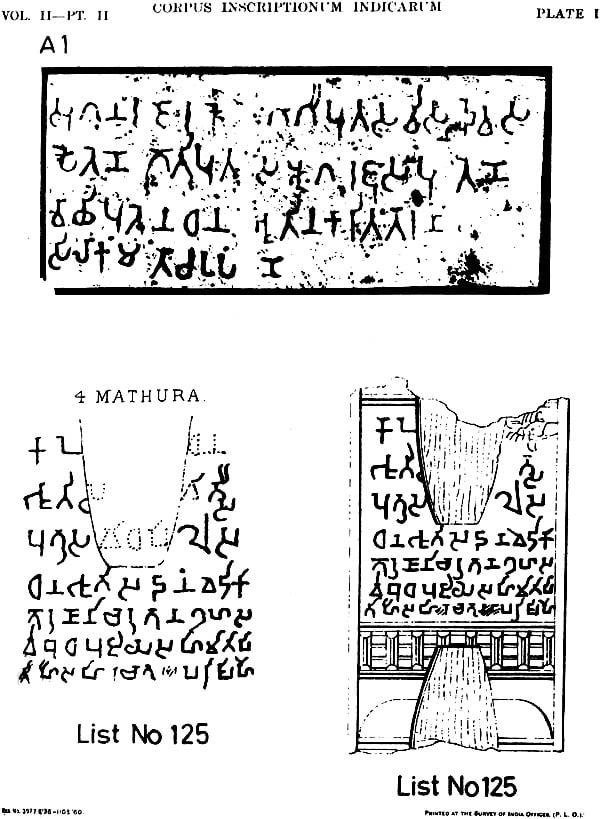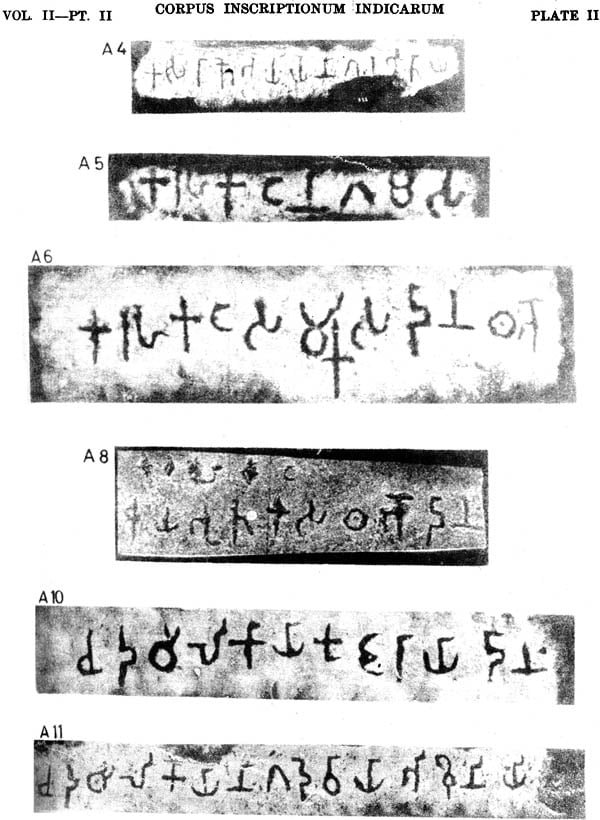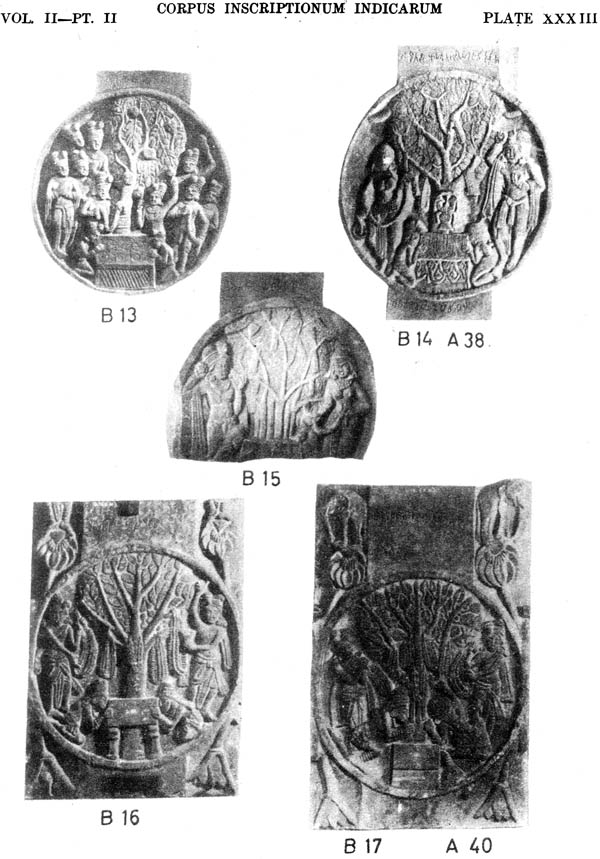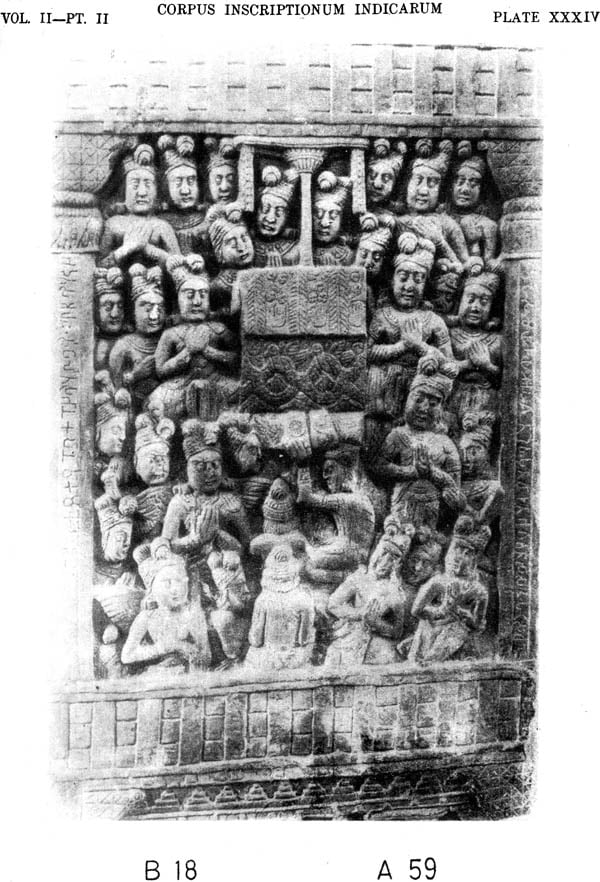
Bharhut Inscriptions (Corpus Inscriptionum Indicarum) (An Old and Rare Book)
Book Specification
| Item Code: | NAL099 |
| Author: | H. Luders |
| Publisher: | ARCHAEOLOGICAL SURVEY OF INDIA |
| Language: | English |
| Edition: | 1998 |
| Pages: | 341 (throughout B/W Illustrations) |
| Cover: | Hardcover |
| Other Details | 10.5 inch X 8.5 inch |
| Weight | 1.10 kg |
Book Description
As can be seen from the preface to Prof. Sten Konow's edition of the Kharoshthi Inscriptions, more than thirty years ago arrangements were concluded for the preparation of a volume of early Brahmi and Kharoshthi Inscriptions in CII. The joint editorship of this volume was entrusted to Professors Hiders (Brahmi inscriptions) and Rapson (Kharoshthi inscriptions). In 1922, however, Prof. Rapson relinquished his post on account of other engagements, and Prof. Konow took over the charge and succeeded in bringing out the volume referred to above on Kharoshthi inscriptions in about six years.
The task of Prof. Luders was more comprehensive, as the number of early Brahmi inscriptions was comparatively greater than the number of Kharoshthi inscriptions. Moreover Prof. Luders could not devote his whole time to this work as he was preoccupied with many other problems of Indology, though for the last twenty years of his life he tried his best to fulfil the responsibility he undertook. Shortly before his lamented death on 7th May 1943, when he was already seriously ill, he requested Prof. E. Waldschmidt to continue his work on Brahmi inscriptions and bring his unfinished task to an end. After the death of Prof. Luders, Mrs. Hiders handed over the unfinished manuscript of the work on Brahmi inscriptions and other similar manuscripts on different subjects to Prof. Waldschmidt. As Prof. Waldschmidt was then in the military service, all this manuscript-material was put into trunks and kept securely in a safe in the Berlin Academy, of which Prof. Luders was a prominent member and head of the Oriental Commission. Later, these trunks, together with other precious material in the Berlin Academy, were brought for security purposes into a mine at Bernburg. After the war, in the summer of 1945 the trunks were plundered and their contents scattered, with the result that some of this valuable material was lost in the confusion. What remained was collected by an official of the Berlin Academy and was again entrusted to the charge of Prof. Waldschmidt.
After putting this material into proper order and on inspecting it, Prof. Waldschmidt noticed that in the material before him there was nearly nothing from the second group of Brahmi inscriptions which is styled as " Southern Inscriptions" in Prof. Luders' List and which begins with the number 962. Evidently Prof. Luders intended to publish the Northern and Southern Brahmi Inscriptions separately in two volumes, and it was obvious that he first worked only on the northern inscriptions. Even the manuscript of Prof. Luders on Northern inscriptions was not complete when it came to the hands of Prof. Waldschmidt, and there were many lacunae which needed to be filled in. It is difficult to decide whether these lacunae were already there as Prof. Luders had not worked out these parts or whether they were results of the plundering and mishandling of the trunks. It seems, however, certain that Prof. Luders had not written the introduction to his intended volume treating the questions relating to the different eras and other points of general interest. Similarly the treatment on language of the different groups of inscriptions as also the various indices were missing in the manuscript. The bulk of the manuscript as it then existed dealt with the Mathura and Bharhut inscriptions besides some other smaller groups and separate inscriptions of major importance. Hence Prof. Waldschmidt proposed in 1947 to the then Director General of Archaeology to publish the material in different fascicles, beginning with the Bharhut inscriptions as this was the most complete group in the manuscript of Prof. Luders. The present work was undertaken after Prof. Waldschmidt's proposal was accepted in a letter No. 21 A/12/49-4886 dated 11th April 1949 of the Superintendent of Publications, Department of Archaeology, Government of India, New Delhi.
The year 1941 saw the publication of Prof. Luders' book on "Bharhut und die buddhistische Literatur" (Abhandlungen fur die Kunde des Morgenlandes, XXVI, 3, Leipzig 1941), and in this book the author discussed many of the Bharhut inscriptions. On comparing the treatment of certain inscriptions as contained in the unpublished manuscript intended for the ClI, and in the published work on Bharhut, it was found, that in some respects the latter showed an advance over the former. The published work contained in certain cases a more detailed discussion, besides a treatment of some general topics like the relation of Bharhut sculptures to the Pali texts, and a criticism of B. M. Barua's work on Bharhut. Hence it seemed necessary to include this material in the present work at proper places, all the more so because copies of Luders' book on Bharhut are no more available.
The recovered material of Prof. Luders as far as Bharhut is concerned comprised the treatment of most of the individual inscriptions. It has been supplemented with an introduction headed by Luders' criticism of Barua's Barhut, and continued by a treatment of general topics, like a discussion of the. language, of the age of the inscriptions, and of the nature of the personal and place names. The index of the words has as well been added. In completing the manuscript of individual inscriptions, the originality of Luders' text has been retained as far as possible. Minor changes and additions were often necessary, but have not been indicated at all places. Similarly the supplementing of the text made with the help of the published work of Luders on Bharhut has not been distinguished as such. The inscriptions, however, on which any treatment whatsoever was missing in the manuscript have been so indicated in the foot notes.
In the present text it was thought advisable to divide the inscriptions into two main groups: A: donative nscriptions, and B: inscriptions describing the sculptural representations, and so to arrange them anew. Consequently it was not possible to maintain the sequence of the numbers found in the List of Brahmi Inscriptions, but these numbers from the List have been mentioned in brackets by the side of new numbers, and in addition a concordance of the old and new numbers has been attached.
In the year 1952, Dr. M. A. Mehendale of the Deccan College Research Institute, Poona (India), arrived at Gottingen and joined Prof. Waldschmidt in his work on Bharhut inscriptions.
The work published by Sir Alexander Cunningham on his excavations at Bharhut was at his time an important achievement, because the reproduction of the sculptures was done in original photographs and not in sketches as usual up to that date. Cunningham, helped by Subhuti, also began the interpretation of the sculptures, to which work in later time Andersen, Chavannes, Coomaraswamy, Foucher, Hultzsch, Minayeff, Oldenburg, Rhys Davids, Rouse, Waldschmidt, and Warren contributed with merit. The great progress which has been made in Indian Archaeology and Epigraphy and in the investigation of Buddhist literature since the publication of Cunningham's book made the re-edition of the finds urgently desirable. The first step in this direction was undertaken by Barua and Sinha in 1926, when they published a new edition of the inscriptions at Bharhut, Later on Barua endeavoured to give in a work of three volumes an exhaustive account of all questions regarding the stupa.
One has to admit thankfully that the material offered for investigation in Barua's latest work is quite large and improved. The 97 plates in part III show a row of culptures never published before, and some reproductions are more complete or appear on a bigger scale. The technical make-up of his plates is generally very good; but in spite of this one has to refer here and there to the old photographs of Cunningham which are more clear.
The kernel of Barua's publication is the second Book which contains the description and the identification of sculptures and bears the title "Jataka-Scenes". Vogel already opposed the designation of the sculptures as Jataka-Scenes, JRAS. 1927, p. 593 ff., but Barua neglected this fully justified criticism. The number of real Jatakas up to then identified at Bharhut was 32; according to the list given in Barhut I, p. 86 ff., Barua has enlarged it to double that number. But unfortunately this apparently great rise in identifications proves to be an illusion. Barua indeed has the merit to have explained convincingly a number of representations for the first time. He identified rightly, as I believe, the figures on pillars represented on Cunningham'S plate XIV and XV (see B 60 and B 61) with with the main persons of the Kandarij. (341) and of the Samuggaj. (436). Besides, he succeeded in identifying the 'fragment' on plate XXVII with the Sammodamanaj. (33), plate XXXIII, 7 with the Kapij. (250), and the scene of the medallion inBarhut III, PI. XCIII (141a) with the Guthapanaj. (227). Not quite sure, but not improbable, is the identification of reliefs on PI. XLI 5 with the Suchij. (387) and the reliefs in Barhut III, PI. LXXI (92) with the Kanhaj. (29). With this, the number of identifications which are acceptable, comes to an end. The identification of the relief on PI. XXXIV 1 with the Vannupathaj, (2) is not convincing. The same has to be said of the identification of the relief on PI. XXXII 4 with the Samgamavacharaj. (182) and of the reliefs on PI. XLVIII 4 (see B 63) with the Mulapariyayaj. (245). His endeavour to bring together at all cost every sculpture with some text, and as far as possible with some jataka, very often led Barua to completely unjustifiable and sometimes even impossible combinations.
On PI. XLVII 9 (see B 64), we have a relief in which a woman-she is according to the inscription the young wife Asadha-sits on the branches of a tree in a cemetery and tells something to three jackals. I ask myself in vain what that has to do with the Asilakkhanaj. (126), as in the Jataka the king's daughter does not climb up a tree, and also has no reason to do so, and the jackals do not play any role. Likewise I do not understand, how it is possible to explain the horse in the half-medallion represented in Barhut III, PI. XXVI as the famous horse Valaha, which, according to the Jataka (196), brings home 250 merchants, whereas, according to the Divy. p. 120, only the merchant Supriya is brought home. In the medallion a horse is to be seen, being led by a man with a rein, while another man with a spear in hand follows him. The horse is certainly not, as Barua maintains, represented as flying. Besides, the man with the spear, whom nobody would suppose to be a merchant, does not hold fast to the tail of the horse, as told in the story. Barua's opinion that the artist intended to suggest through the man before the horse, that the horse was having a human voice, will not find common consent. Probably the half medallion is purely decorative, and the representation is chosen with regard to the profession of the donor of the pillar, viz. the horseman (asavarika) Suladha (Sulabdha), cf. A 22. It. seems to me also in no way reasonable to identify the relief on PI. XLII 9 with the Chullakasetthij. (4), or even with the Gandatinduj. (520), or to combine the relief on PI. XLII 7 with the Madhupindika-Apadana (Ap. 97). The relief on PI. XLVI 4 is being explained by Barua as the illustration of the Kisa Vaccha episode (J.V, 134, 3 ff.) in the Sarabhangaj, (522). In that case we are asked to believe, that the man who in the relief stands with folded hands before an ascetic is the king who, according to the story, is deeply offended by him because of his spitting. I also consider the interpretation of the relief on the PI. XLIV 4 and its identification with the Gahapatij. (199) as totally wrong. In any case the man to the left does not lie on the earth, being caught in a noose. On the contrary, he sits in a position called in Sanskrit avasakthika, in Pali samghati- or dussapallatthika and which, as the name indicates, consists in binding the garment round the knees and hips for support. The ascetic in the relief on PI. XLVI 4 is also sitting in the position of samghatipallatthika, his right arm, however, being free, while the man in our relief has put the arm in the supporting tie made from his garment.
The treatment by Barua of our inscription No. B 80 (for particulars cf. below) is a further example to show on what unfounded suppositions his identifications are sometimes based. It is also characteristic of the method of Barua, to see how he deals with a small fragment of a coping stone, that is preserved in the Indian Museum and has been reproduced for the first time in Barhut III, PI. LXXV (98). Barua completes the sculpture which bears our inscription B 65 (cf. our treatment) by the photograph of another which, however, as everybody will see at first sight, does not fit in with the former. In this way he finds it possible to identify the relief with the Indasamanagottaj. (161) or with the Mittamittaj. (197).
Barua's lack of knowledge and feeling for the language has also become a rich source of errors. Barua and Sinha show often in their interpretations of labels a disregard for even the most simple rules of phonology. The inscription B 45 reads Sechhajataka. It is probably not to be expected of the authors to know that sechha is the western form of Sanskrit Saiksha and that sekha, the eastern form, has been taken over into Pali, but the identification of sechha with sincha, secha, under express rejection of the right etymology, and the translation based thereon as ' a Jataka-episode of water-drawing ', is more than can be forgiven even to a beginner. One may judge the Kodayo in our inscription B 72 as one likes, but that it cannot go back to Kodi-raja or kottaraja and that it cannot mean 'fort-keeper’ need scarcely be pointed out. On the name of the mountain Nadoda occurring at different times in the labels (cf. B 70-76) it is said in BI. p. 98: " Nadoda seems to equate with Nalada or Narada, and is obviously used as a synonym for Gandhamadana, nala or nalada meaning a scented plant or mineral". In the translations of the labels in Barhut II, p. 162, 165, 169, Nadoda is accordingly simply substituted by "Mt. Narada ", Any comment seems to me to be superfluous. The inscription B 66 Bramhadevo manavako is translated as "the young [Rupa-]Brahma deity Subrahma" or "the youthful Rupabrahma deity"; the scene has been explained as a greeting of the Buddha by the Brahmakayika goddesses after he had attained Bodhi. That in fact would be a very curious representation of the event. But it is not necessary to deal with it any further, for the inscription can only mean' the young Brahmin Brahmadeva', and that any. relation of the relief to the Rupabrahman goddesses is missing is obvious.
Finally even representations rightly explained for a long time have been wrongly interpreted by Barua. The story of the bullock and the jackal forming the basis of the relief on Cunningham's plate XXVII 10 was found years ago by Chavannes, Contes at Apologues I, p. XI in some Buddhist text. Barua does not know of it and wants to combine the relief and the Vakaj. (300) which has quite different contents. The scene represented on the pillar of the South-West quadrant having the inscription Yavamajhakiyam jatakam (PI. XXV 3) has already been explained rightly by Cunningham (p. 53 ff.) in its main features, although he had access only to the later versions of the story in the Brihatkathamanjarl and in the Kathasaritsagara. Minayeff later on hinted at the story of the prudent Amaradevi and the four ministers in the Mahaummaggaj. (546) as the model of the artist. The representation exactly follows the text. Barua' manages to identify the relief with two different episodes of the Mahaummagga-.Jataka on the basis of some unbelievable misinterpretations of the details.
But I may stop here. If I wanted to mention all the unjustified conclusions, all the contradictions, inexact and unclear matters found throughout the work of Barua I should have to fill many pages. They are as numerous as the many misprints and false citations.
| Preface | V-VI | |
| Introduction | IX-XXXIV | |
| (I) | Luders' criticism of Barua's work on Bharhut | IX-XII |
| (II) | The Language | XIII-XXIX |
| (III) | Date and Palaeography | XXX-XXXIV |
| References of Inscriptions to Plates | XXXV-XXXVI | |
| Location of Bharhut inscriptions as described by General Cunningham | XXXVII-XXXVIII | |
| Donative inscriptions | 1-65 | |
| (a) | Formal aspect | 1 |
| (b) | Contents-Personal names - Place-names | 1-10 |
| (c) | Text-Translation-Notes: A1-136 | 11-65 |
| 1 | A 1 - 4 Donations by members of the royal family | 11-15 |
| 2 | A 5 - 54 Donations by inhabitants of certain places | 16-35 |
| (a) A 5 - 9 Inhabitants of Karahakata | 16-17 | |
| (b) A 10 - 12 Inhabitants of Chudathila | 17-18 | |
| (c) A 13 - 15 Inhabitants of Pataliputra | 18-20 | |
| (d) A 16 - 20 Inhabitants of Purika | 20-21 | |
| (e) A 21 - 22 Inhabitants of Bibikanadikata | 21-22 | |
| (f) A 23 - 24 Inhabitants of Bhojakata | 22-23 | |
| (g) A 25 - 29 Inhabitants of Moragiri | 23-25 | |
| (h) A 30 - 35 Inhabitants of Vedisa | 25-27 | |
| (i) A 36 - 54 Inhabitants of various places mentioned only once | 27-35 | |
| 3 | A 55 Donations by a sculptor (without reference to the native place) | 36 |
| 4 | A 56 - 73 Donations by monks | 37-43 |
| (a) A 56 - 63 Monks having specific church titles | 37-40 | |
| (b) A 64 - 73 Monks called bhadanta or aya | 40-43 | |
| 5 | A 74 - 80 Donations by nuns | 44-45 |
| 6 | A 81 - 113 Donations by men (without reference to native place or profession) | 46-56 |
| 7 | A 114 - A 128 Donations by women (without reference to native place) | 57-62 |
| 8 | A 129 - A 136 Unclassified fragmentary donative inscriptions | 63-65 |
| Inscriptions describing the sculptural representations | 66-181 | |
| (a) | The sculptural representation and the textual tradition | 66-71 |
| (b) | List of the Jatakas identified | 72 |
| (c) | Text-Translation-Notes: B 1 - B 82 | 73-181 |
| 1 | B 1 - B 12 Inscriptions attached to the figures of demi-gods and goddesses | 73-81 |
| 2 | B 13 - B17 Inscriptions attached to Bodhi-trees of the former Buddhas | 82-86 |
| 3 | B 18 - B 40 Inscriptions attached to certain scenes from the life of the Buddha | 87-119 |
| 4 | B 41 - B 62 Inscriptions attached to identified scenes from Jatakas and Avadanas | 120-158 |
| 5 | B 63 - B 67 Inscriptions attached to Jataka or Avadana-scenes not yet identified | 159-163 |
| 6 | B 68 - B 69 Inscriptions attached to the representations of Chaityas | 164-166 |
| 7 | B 70 - B 76 Inscriptions referring to the legends connected with mount Nadoda | 167-173 |
| 8 | B 77 - B 78 Inscriptions attached to the representations of Chankamas | 174-178 |
| 9 | B 79 - B 82 Fragmentary inscriptions referring to Jatakas or religious legends | 179-181 |
| Concordance of Luders' List numbers and the numbers in the present work | 182 | |
| List of abbreviations | 183-185 | |
| The Bharhut inscriptions alphabetically arranged | 186-190 | |
| Word Index to the Bharhut Inscriptions | 191-201 |
